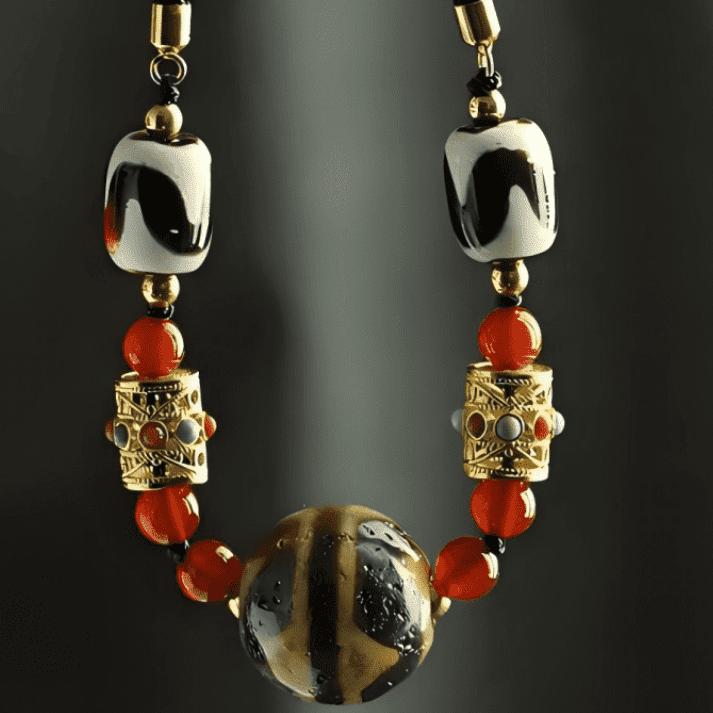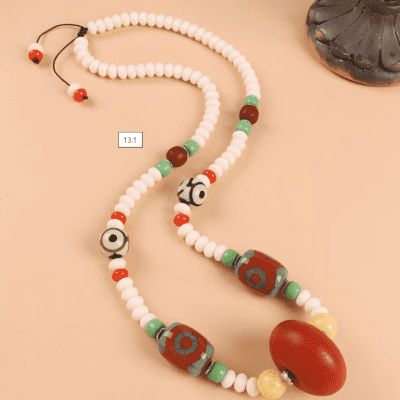Tibetan Beeswax Necklaces: Mysticism, Healing, and Sacred Tales from the Himalayas

1. What is a Tibetan beeswax necklace?
The Tibetan beeswax necklace is a sacred bead revered in Himalayan Buddhism for meditation, prayer, and spiritual protection. These necklaces are made from aged beeswax, dzi, coral, and turquoise and usually have 108 beads, but there are also shorter versions (54, 27, 21 beads) for daily practice.
Traditional Structure: Each necklace begins with a larger “main bead,” typically an ancient beeswax amulet or a powerful Dzi, representing the guru-disciple bond and the cycle of prayer. The spacer beads are marked every 27 beads to guide the practitioner through meditation. The silk tassels at the ends symbolize unity with the divine, like the threads of a mandala.

2. Historical origins and Himalayan mythology
Tibetan beeswax necklaces carry legends as old as the Himalayas. A sacred story tells of a 17th-century lama who received a vision during a meditation retreat: a golden bead of beeswax descended from the sky and merged with a meteorite (later carved into a dzi) to form the first blessed necklace. This artifact is said to protect a village from devastating earthquakes, and its tassels wave like the hands of a guardian.
Monastic traditions: For centuries, Tibetan monks handcrafted these necklaces in secluded retreats. During the full moon ceremony, each bead is infused with a spell, and beeswax collected from high-altitude Himalayan bees is believed to absorb the purity of the snow-capped peaks. These necklaces traverse the Silk Roads, bringing blessings to distant lands while absorbing local spiritual energy.
3. The material and its Tibetan spiritual significance
- Himalayan Beeswax: This golden wax is harvested from bees that feed on medicinal mountain flowers, symbolizing purity and enlightenment. Its warm glow is said to dispel negative thoughts, just like the sun melts winter snow.
- Dzi: These ancient eye-patterned stones are rumored to be fragments of celestial armor that fell to Earth in the form of meteors. Each eye in the Dzi guards a different realm, warding off evil spirits and attracting wisdom.
- Red coral: Harvested from the depths of the sacred lake on the Tibetan Plateau (legend has it to be), red coral represents vitality and courage, contrasting with the bright hues of the monk’s robe.
- Turquoise: The “stone of the sky” in Tibet, turquoise connects the wearer with the sky, enhancing intuition and spiritual communication. Its blue-green hue echoes the colors of Lake Manasarovar, a pilgrimage site of profound power.
4. The power of 108 beads in Tibetan tradition
In Tibetan Buddhism, 108 is not just a number, but a gateway to the divine. 108 beads correspond to:
- 108 earthly desires that bind us to suffering;
- Each of the 108 deities in the Tibetan pantheon is ready to bestow blessings;
- 108 prostrations performed by monks during their pilgrimage.
Astronomical Mysticism: Tibetan astrologers note that 108 equals the number of beads in the rosary and the number of stars visible in the Himalayan night sky during the full moon – linking the necklace to the cosmic rhythm. Rotating the beads clockwise aligns the wearer with the rotation of Mount Kailash, the spiritual center of Tibet.
5. How to use a Tibetan beeswax necklace
- Meditation ritual: Hold the necklace with your right hand and place it on your middle finger. Move each bead towards you with your thumb, chant a mantra (e.g., “Om Mani Padme Hum”) or focus on your breath. Avoid the index finger – in Tibetan legend, it is considered too closely connected to the self. Start with the main orb and complete 108 cycles in honor of the divine.
- Blessing Ceremony: Before wearing, purification is the key. Light juniper incense (a Tibetan holy medicine), pass the necklace through the smoke, and imagine the dissolution of negativity. Whisper your intentions to the main bead – whether it’s healing, wisdom, or protection.
- Daily Contact: Wear the necklace on your heart. Whenever you touch a bead, let it remind you to stop, breathe, and reconnect with your spiritual purpose – just like a monk stopping to turn the prayer wheel.
6. Symbolism and sacred significance
- Master bead: This central bead commemorates the Guru of the Source of Wisdom. It is also seen as a manifestation of the Buddha’s compassion or as the wearer’s own inner teacher. Touching it ends a cycle of prayer, like sealing a letter to God.
- Circle Infinity: The necklace’s circular shape represents reincarnation – the eternal cycle of birth, death, and rebirth. Wearing it reminds us that spiritual growth is an ongoing journey, not an end.
- Unifying Tassel: The thread of the tassel symbolizes the interconnectedness of all beings, from the highest lama to the smallest insect. It whispers that every prayer is beneficial to the entire universe.
7. Different types of Tibetan beeswax necklaces
- Blessing Necklaces (Colorful Treasures): These necklaces are adorned with a series of beads (coral, turquoise, dzi) designed for daily blessings. Each color aligns with different virtues – red for courage and blue for tranquility.
- Temple Blessing Necklaces: These necklaces undergo strict rituals in Tibetan monasteries, where monks chant mantras on each bead for 108 days. The beeswax here has been aged for decades, absorbing countless meditative prayers.
- Wrist Rosary (Portable Peace): Abbreviated as 27 beads (27 forms in honor of Tara, the goddess of mercy), wrapped around the wrist. They’re perfect for busy lives, providing quick moments of mindfulness – like a mini retreat in your pocket.
8. Caring for Your Sacred Necklace
- Energetic Cleansing: Tibetan tradition uses smoke (juniper or sage) to purify the necklace. Once a month, place it under the light of the full moon—Himalayan lore says the moon’s rays recharge the beads’ blessings.
- Physical Care: Wipe beeswax beads with a soft cloth dampened with pure water (never chemicals). Avoid exposing turquoise to harsh sunlight, as it may fade—treat it like a fragment of the sky.
- Restringing with Intention: When the thread wears out, restring the beads during a meditation session. As you thread each bead, recite a mantra or set a new intention—this rebirth of the necklace mirrors your spiritual growth.
9. Modern Healing Applications
- Stress Alchemy: The tactile feel of beeswax and dzi beads calms the nervous system. Running your fingers over the warm wax during a busy day is like holding a piece of the Himalayas—grounding and soothing.
- Mindfulness Anchor: In a world of distractions, the necklace becomes a physical reminder to stay present. Each bead is a tiny bell, calling you back to the now.
- Sleep Sanctuary: Place the necklace on your bedside table. Its ancient energy creates a protective field, warding off nightmares and inviting peaceful dreams—like sleeping near a monastery’s altar.

10. Conclusion
A Tibetan beeswax necklace is more than adornment—it’s a living bridge between the earthly and the divine. Woven with Himalayan myths, sacred materials, and centuries of prayer, it carries the power to heal, inspire, and transform. Whether you seek protection, wisdom, or simply a touch of Tibetan mysticism, these necklaces offer a path to deeper connection—one bead at a time.
11. FAQs
Q: What makes Tibetan beeswax special?
A: Himalayan beeswax is infused with the energy of high-altitude herbs and pure mountain air, carrying a unique vibrancy said to calm the mind.
A: Himalayan beeswax is infused with the energy of high-altitude herbs and pure mountain air, carrying a unique vibrancy said to calm the mind.
Q: Can anyone wear a Tibetan beeswax necklace?
A: Yes—these necklaces welcome all who approach with respect. Their energy is inclusive, offering healing to seekers of any background.
A: Yes—these necklaces welcome all who approach with respect. Their energy is inclusive, offering healing to seekers of any background.
Q: How do I know if a necklace is authentic?
A: Look for signs of age in the beeswax (a smooth, worn patina) and the dzi beads’ intricate patterns. Authentic pieces often come with stories from Tibetan artisans or monasteries.
A: Look for signs of age in the beeswax (a smooth, worn patina) and the dzi beads’ intricate patterns. Authentic pieces often come with stories from Tibetan artisans or monasteries.
Q: What if I don’t practice Buddhism?
A: The necklace’s power lies in intention. Even without formal practice, using it as a mindfulness tool or a symbol of peace can bring profound benefits.
A: The necklace’s power lies in intention. Even without formal practice, using it as a mindfulness tool or a symbol of peace can bring profound benefits.
